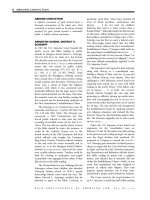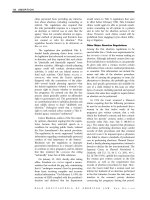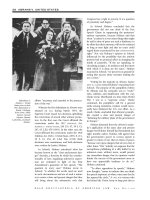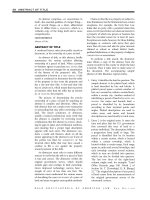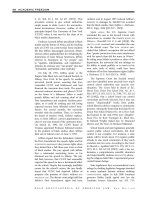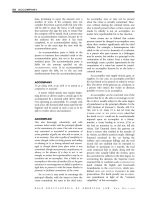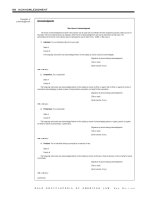Gale Encyclopedia Of American Law 3Rd Edition Volume 1 P38 pptx
Bạn đang xem bản rút gọn của tài liệu. Xem và tải ngay bản đầy đủ của tài liệu tại đây (304.24 KB, 10 trang )
implementing the new rules, and many critics
felt that the policy further polarized attitudes
among service members. Furthermore, the policy
shifted the
BURDEN OF PROOF to the individual
to show that she or he had not engaged in
homosexual acts.
The first legal challenge to the “don’t ask,
don’t tell, don’t pursue” policy was filed in
March 1994 by the
AMERICAN CIVIL LIBERTIES UNION
and the Lambda Legal Defense and Education
Fund. Six service members who had declared
their h omosexuality file d suit i n the U.S. District
Court for the E astern District of Ne w Y ork, asking
for injunctive relief and a declaration that the
policy was unconstitutional. The case was heard
by Judge Eugene H. Nickerson who issued orders
on April 4, 1994, and June 3, 1994, enjoining
the Army from pursuing discharge proceedings
against the plaintiffs. Nickerson based his de ci-
sion on the plaintiffs’ showing that they would
suffer irreparable harm if the injunction were not
granted and that the case involved “sufficiently
serious questions” that would wa rrant its go ing
forward for a decision on its merits.
The U.S. Court of Appeals for the Second
Circuit found that Nickerson had used an
incorrect standard in determining whether the
injunction should be granted. It held that in a
case such as this, where an injunction is sought
against a “government action taken in the
PUBLIC
INTEREST
pursuant to a statutory or regulatory
scheme,” a more rigorous showing that the case
has a “likelihood of success” must be made
(Able v. United States, 44 F.3d 128 [1995][per
curiam]). The court allowed the injunctions to
stand but remanded the case to the district
court for a decision on the plaintiffs’ constitu-
tional claims within three months.
On March 30, 1995, Judge Nickerson
delivered the decision the plaintiffs had hoped
for. He held that the “don’t ask, don’t tell, don’t
pursue” policy violated the First and Fifth
Amendments, and enjoined the government
from enforcing the policy against the plaintiffs
(Able, 880 F. Supp. 968 [E.D.N.Y.] ). The court
found that the
FIRST AMENDMENT prohibits a
restraint on the right of a serviceperson to
declare his or her homosexuality. According to
the court, “Plaintiffs have done no more than
acknowledge who they are, that is, their status.
The speech at issue in this case implicates the
First Amendment value of promoting individual
dignity and integrity and thus is protected by
the First Amendment from efforts to prohibit it
because of its co ntent.” The court further found
that to regulate speech content, even in the
military context, the government must show a
“compelling interest” and prove that it has
chosen the “least restrictive means” to further
that interest. Nickerson criticized the legal
hairsplitting in the policy directives, which
purported to differentiate between a homosex-
ual “orientation” and a homosexual “propensi-
ty.” Once a member of the armed services has
admitted or acknowledged being a homosexual,
he or she has only a hypothetical chance of
escaping discharge. “Thus, the policy treats a
statement of homosexual orientation as proof
of the case,” said Nickerson. “Once such a
statement is made, the speaker is judged guilty
until proven innocent of committing miscon-
duct the government considers so threatening
to the military mission that a member may be
discharged for it. This seems to the court a
rather draconian consequence of merely admit-
ting to an orientation that Congress has
determined to be innocuous.”
Turning to the government’s argument that
the presence of openly gay or lesbian members
would be detrimental to morale and troop
cohesion, the court found that sufficient sanc-
tions were available for dealing with “inappro-
priate behavior by a homosexual, whether in the
closet or not.” Nickerson further stated his
belief that the policy may actually be detrimen-
tal to the military becaus e “secrecy and dec ep-
tion invite suspicion, which in turn erodes trust,
the rock on which cohesion is built.” He noted
that a 1993 study conducted by the RAND
Corporation found that in countries that have
nondiscrimination policies, “no serious pro-
blems were reported concerning the presence of
homosexuals in the force.”
Finally, o n t he Fifth Amendment equal protec-
tion question, the court found that the government
had failed to show that the policy, which denied to
gay and lesbian personnel the same free speech
rights guaranteed to heterosexuals, was “tailored to
serve a substantial governmental interest.” The
policy therefore violated the Fifth Amendment as
well as the First, and the court enjoined the
government from enforcing it.
The military policy of “don’task,don’ttell”
has remained intact since 1993. Despite calls for
repeal of the policy and return to the former policy
of excluding gay and lesbian personnel from
GALE ENCYCLOPEDIA OF AMERICAN LAW, 3RD E DITION
358 ARMED SERVICES
service, President George W. Bush did not
change the policy, and EXECUTIVE BRANCH officials
stated that the administration does not plan to
change the policy. The controversy has neverthe-
less remained heated. Commentators have noted
that the ban on gays and lesbians does not apply
to such governmental agencies as the Central
Intelligence Agency, which often engages in quasi-
military activities. Moreover, evidence suggests
that during times of war in the past, the military
has allowed gays to remain in the service.
Legal challenges to the “don ’t ask, don’ttell”
policy continued in the 2000s. In Witt v.
Department of Air Force, 527 F.3d 806 (9th
Cir. 2008), an Air Force nurse named Margaret
Witt challenged her suspension from the
military due to discovery that she was engaged
in a lesbian relationship. Witt argued that the
military’s action violated her equal protection
and due process rights. Although the court
concluded that the government’s policy ad-
vanced an important governmental interest of
managing the military, the court was not
convinced that the policy significantly furthered
the government’s interest. The court remanded
the case to a federal district court in Washing-
ton for further proceedings.
As a presidential candidate,
BARACK OBAMA
asserted that he would reverse the military’s
policy regarding gays and lesbians. Early in his
administration, however, Obama decided not to
address the policy until the Witt
LITIGATION had
been resolved.
Sexual Harassment in th e Armed Servi-
ces The inclusion of women in virtually all
aspects of military life has changed the service
from a male-dominated enterprise, strictly seg-
regated by gender, into a microcosm of modern
society. Although most men and women serve
side by side without incident, charges of
SEXUAL
HARASSMENT
in the military became increasingly
numerous in the 1980s, 1990s, and 2000s.
Perhaps the most explosive and far-reaching
incidence of this problem took place at the
Tailhook Association convention in Las Vegas in
September 1991. The Tailhook Association—
named for the hook on a Navy jet that catches
on the cables that stop it as it lands on an aircraft
carrier—is a private group of active and retired
Navy and Marine Corps pilots. After its 1991
meeting, Navy lieutenant Paula A. Coughlin
charged that she and other women who unwit-
tingly stumbled upon the Tailhook hospitality
suites at the Las Vegas Hilton were forced to go
through a “gauntlet” of drunken Navy and Marine
officers who assaulted them, tore at their clothing,
and grabbed at their bodies as they were pro-
pelled down the hallway. Coughlin’sallegations
launched an investigation that revealed drunken,
lewd, and out-of-control behavior by the officers.
In the ensuing months the Navy severed its
ties to the Tailhook Association and submitted
the names of more than 60 officers for possible
disciplinary action. Nevertheless, a conspiracy of
silence among the aviators hampered the investi-
gation. In September 1992 the Pentagon’sinspec-
tor general issued a report criticizing the Navy’s
inquiry into the incident and suggesting that
top Navy officials deliberately undermined t he
investigation to avoid negative publicity. The
commander of the Naval Investigative Service
and the Navy’s judge advocate general were
relieved of their commands. The following April,
the inspector general accused 140 aviators of
indecent exposure, assault, and lying under oath
in the incident. However, no one was ever court-
martialed as a result of the charges, and those
who were disciplined received only small fines
or reprimands.
The Tailhook scandal set off a tidal wave
within the upper echelons of the Navy. Navy
Secretary H. Lawrence Garrett III resigned in
June 1992, accepting full responsibility for the
failure of leadership that allowed the incident to
occur. In October 1993 his replacement, John H.
Dalton, asked for the removal of Admiral Frank
B. Kelso II, chief of naval operations, who was
present at the convention but denied any
knowledge of the debauchery. Dalton’srequest
was overruled by Secretary of Defense Les Aspin.
In February 1994 a military judge cited Kelso for
using “unlawful command influence” to “ma-
nipulate the initial investigative process” and the
Navy’s d isciplinary procedures “to shield his
personal involvement” in Tailhook. Kelso, who
was to retire on June 30, 1994, angrily denied any
wrongdoing and declared that he would not
resign early. In the end, however, he was
persuaded to step down two months ahead of
schedule in exchange for a tribute from Defense
Secretary William J. Perry that would clear his
name. After a bitter debate, the U.S. Senate voted
54 to 43 to allow Kelso, the Navy’stopadmiral
and a 38-year veteran, to retire at his full four-
star rank and with a full pension. The women in
the Senate, along with many of their male
GALE ENCYCLOPEDIA OF AMERICAN LAW, 3RD E DITION
ARMED SERVICES 359
colleagues, vehemently opposed the arrange-
ment, but they were ultimately overruled.
Coughlin resigned from the Navy in Febru-
ary 1994, stating that the assault and “the covert
attacks on me that followed have stripped me of
my ability to serve.” Coughlin was successful in
a civil suit against the Tailhook Association,
with whom she settled for an undisclosed
amount. She also won a civil suit against the
Hilton Hotels Corporation, parent company of
the Las Vegas Hilton, which she accused of lax
security; in October 1994 a jury awarded her
$1.7 million in
COMPENSATORY DAMAGES and an
additional $5 million in
PUNITIVE DAMAGES. Still
suffering depression and post-traumatic stress
from the incident, Coughlin expressed satisfac-
tion with the award but uncertainty about her
future, saying, “I’m hoping to slip into obscuri-
ty. I want to paint my house. I just want to go
home.”
Anxious to restore the Navy’s tarnished
image after the sordid series of events, top
officials vowed to handle sexual harassment
charges swiftly and sensitively. The Navy’s new
“zero-tolerance” policy on sexual harassment
required automatic dismissal for aggravated
sexual harassment or repeat offenses. Under
the policy, about 90 officers and sailors had
been dismissed by the end of 1994.
In spite of the publicity generated by Tailhook
and other scandals, and the efforts of the military
to clamp down on sexual harassment, charges
continued to come to light. In one 1994 case that
tested the resolve of Admiral Jeremy M. Boorda,
Admiral Kelso’s successor as chief of naval
operations, two officers were reprimanded for
failing to act properly on complaints by Lieutenant
Darlene Simmons. Simmons charged that her
commanding officer, Lieutenant Commander
Arthur Catullo, had offered to advance her career
in exchange for sexual favors. Catullo was
censured. Simmons, who had an impeccable
record before she brought the charges but received
an “adverse” evaluation afterward, received an
apology from Navy Secretary Dalton. Dalton also
cleared her record and offered to extend her
active-duty Navy service by two years.
Another egregious incident, again involving
the Navy, occurred in 1994 when four male
instructors were court-martialed and six others
punished for sexually harassing 16 women
students at the Naval Training Center in San
Diego. The women, who were learning to
operate the Navy’s computer and telephone
networks, claimed that the male instructors
made unwanted verbal and physical advances.
After a seven-month investigation, the Navy
found all but one of the instructors guilty of
the charges and imposed various sanctions,
from a criminal conviction and $1,000 fine, to a
loss in pay, required counseling, and inclusion
of punitive letters in their files.
Sexual harassment was also found among the
ranks at the U.S. Military Academy, at West Point,
New York. In October 1994 female cadets
complained that they had been groped at a pep
rally by members of the West Point football team
as the players ran past them in a regimental “spirit
run.” Lieutenant General Howard D. Graves,
superintendent of West Point, launched an
immediate investigation that resulted in three
players being suspended from the team for the rest
of the season, restricted to academy grounds for 90
days, and given 80 hours of marching discipline.
Representative Patricia Schroeder (D-Colo.), a
member of the House ArmedServicesCommittee,
criticized the punishment as too lenient, saying,
“[I]tlookslike[the incident] was treated as a prank
and not as a serious violation of the code of
conduct.”
Despite the attention placed on the problem
of sexual harassment in the military, incidents
of sexual harassment have remained relatively
common. According to a report released by the
Pentagon in 2008, about one-third of military
women polled said that they experienced sexual
harassment in 2006.
Sexual misconduct by servicemen is not
limited to sexual hara ssment. The Army ac-
knowledged in 1992 that soldiers committed at
least 34 sex crimes during the Gulf War in 1991,
including
RAPE and assault against fellow U.S.
soldiers. One sergeant was charged with rape,
indecent assault, and adultery after he allegedly
raped several female soldiers in the port of Al
Jubayl in Saudi Arabia in 1991. Some of the
crimes reported by the Army at that time
included consensual sexual activities, including
adultery and gay and lesbian conduct. Army
records disclosed few records regarding actions
taken against the soldiers for their miscondu ct.
Four years later, three U.S. soldiers, two
marines, and a sailor stationed near Japan,
abducted and raped an 12-year-old Okinawa
schoolgirl, in part prompting Okinawa citizens
to call for the closing of U.S. military bases on the
GALE ENCYCLOPEDIA OF AMERICAN LAW, 3RD E DITION
360 ARMED SERVICES
island. The incident likewise enraged citizens of
Japan. According to a study of records in 1988,
Navy and Marine bases in Japan held 169 courts
martial for sexual assaults, far exceeding the
number at any U.S. base elsewhere in the world.
Statistics regarding Air Force courts martial
likewise showed a significant number of assault
charges on bases in Japan.
Prior to 2000, many criminal activities by
military employees went unpunished because
the host country in which the crime occurred
failed to
PROSECUTE the action or the military
courts of the United States did not have
jurisdiction to try the case. In 2000 Congress
enacted the Military Extraterritorial Jurisdiction
Act of 2000, Pub. L. No. 106-523, 114 Stat. 2488
(18 U.S.C.A. §§ 3261-3267), which extends
federal criminal jurisdiction over crimes com-
mitted by military personnel and their depen-
dents stationed abroad. The statute allows the
U.S. Defense Department to order the arrest,
detention, and removal of military employees
for crimes that would constitute an offense
punishable for more than one year if the
conduct had been engaged in within the
jurisdiction of the United States.
Several U.S. soldiers were convicted of some
heinous criminal acts during the Iraq War. One
of the worst incidents occurred in the Iraqi
town of Al-Mahmudiyah in 2006. Five soldiers
attacked the family of a 14-year-old girl, killing
her father, mother, and younger sister before
gang raping the girl. Four of the five soldiers
stood trial by co urt martial, while a fifth was
tried in a federal district court.
FURTHER READINGS
Bravin, Jess, and Laura Meckler. 2009. “Obama Avoids Test
on Gays in Military.” Wall Street Journal.
The Bulletin of the Atomic Scientists. 49, no. 4 (May 1993).
Shanor, Charles A., and L. Lynn Hogue. 1996. Military Law
in a Nutshell. St. Paul, MN: West.
Winthrop, William. 2000. Military Law and Precedents.
Buffalo, NY: William S. Hein.
CROSS REFERENCES
American Civil Liberties Union; Bias; Court-Martial;
Defense Department; Equal Protection; Gay and Lesbian
Rights; Judge Advocate; Military Law; National Guard;
Sexual Harassment; Uniform Code of Military Justice; U.S.
Court of Appeals for Veterans Claims; Veterans Affairs
Department; War.
ARMISTICE
A suspending or cessation of hostilities between
belligerent nations or forces for a considerable
time. An armistice differs from a mere “suspension
of arms” in that the latter is concluded for very
brief periods and for local military purposes only,
whereas an armistice not only covers a longer
period, but is agreed upon for po litical purposes. It
is said to be general if it relates to the whole area
of the war, and partial if it relates to only a
portion of that area. Partial armistices are
sometimes called truces but there is no hard and
fast distinction.
Armistice Day originated as a day set aside
by the United States, Great Britain, and France
to commemorate the signing of the armistice on
November 11, 1918, that brought an end to
WORLD WAR I. After WORLD WAR II, it became a day
for tribute to those who lost their lives in that
General Douglas
MacArthur (top)
signs the Japanese
armistice documents
on the USS Missouri
on September 2, 1945.
Mamoru Shigemitsu
and General Yoshijiro
Umezu, with
delegation, witness.
(TOP) NATIONAL
ARCHIVES AND RECORDS
ADMINISTRATION
(BOTTOM) LIBRARY OF
CONGRESS
GALE ENCYCLOPEDIA OF AMERICAN LAW, 3
RD E DITION
ARMISTICE 361
conflict as well. In Canada it became known as
Remembrance Day, and in Britain the Sunday
closest to November 11 was declared Remem-
brance Sunday to honor the dead of both world
wars. In 1938 the day was made a federal
holiday in the United States.
In 1954 after the
KOREAN WAR, President
DWIGHT D. EISENHOWER signed an act of Congress
(5 U.S.C.A. § 6103 (a) [1995]) to change the
name of the holiday to Veterans Day “to honor
veterans on the eleventh day of November of
each year a day dedicated to world peace.”
Thus, Veterans Day now honors all U.S.
veterans of all wars. From 1971 to 1977 the
holiday was celebrated on the fourth Monday in
October, but in 1978 the traditional date of
November 11 was restored.
Veterans Day celebrations in towns and
cities in the United States usually include
parades, speeches, and floral tributes placed on
soldiers’ graves or memorials, with special
services held at the Tomb of the Unknown
Soldier in Arlington National Cemetery, in
Arlington, Virginia, outside Washington, D.C.
Group
NATURALIZATION ceremonies, in which
individuals are made citizens of the United
States, have also become part of Veterans Day
celebrations.
ARMS CONTROL AND DISARMAMENT
One of the major efforts to preserve interna-
tional peace and security in the twenty-first
century has been to control or limit the number
of
WEAPONS and the ways in which weapons can
be used. Two different means to achieve this
goal have been disarmament and arms control.
Disarmament is the reduction of the number of
weapons and troops maintained by a state. Arms
control refers to treaties made between potential
adversaries that reduce the likelihood and scope
of war, usually imposing limitations on military
capability. Although disarmament always involves
the reduction of military forces or weapons, arms
control does not. In fact, arms control agree-
ments sometimes allow for the increase of
weapons by one or more parties to a treaty.
History
Arms control developed both in theory and i n
practice during the
COLD WAR, a period between
the late 1940s and 1991 when the t wo military
superpowers, the United States and the Union of
Soviet Socialist Republics (USSR), dealt with one
another from a position of mutual mistrust. Arms
control was devised consciously during the
postwar period as an alternative to disarmament,
which for many had fallen into discredit as a
means of reducing the likelihood of war. Germany
had been forced to disarm following
WORLD WAR I
but became belligerent again during the 1930s,
resulting in
WORLD WAR II. Although Germany’s
weapons had been largely eliminated, the under-
lying causes of conflict had not. Germany’s
experience thus illustrated that no simple cause-
and-effect rela tionship existed between the pos-
session of weapons and a tendency to create war.
Following World War II, advocates of arms
control as a new approach to limiting hostility
between nations emphasized that military
weapons and power would continue to remain
a part of modern life. It w as unrealistic and even
dangerous, they felt, for a country to seek
complete elimination of weapons, and it would
not necessarily reduce the likelihood of war.
Whereas disarmament had formerly been seen
as an alternative to military strength, arms
control was now viewed as an integral part of it.
Arms control proponents sought to create a
stable balance of power in which the forces that
cause states to go to war could be controlled and
regulated. The emphasis in arms control is thus
upon overall stability rather than elimination of
arms, and proponents recognize that an in-
crease in weaponry is sometimes necessary to
preserve a balance of power.
The development of arms control owes a
great deal to the existence of
NUCLEAR WEAPONS as
well. By the 1950s, when both the United States
and the Soviet Union possessed nuclear weap-
ons, the superpowers became convinced that
they could not safely disarm themselves of those
weapons. In the absence of guaranteed verifica-
tion—the process whereby par ticipants in a
treaty monitor each other’s adherence to the
agreement—neither side could disarm without
making itself vulnerable to cheating by the other
side. The goal of the superpowers and other
nations possessing nuclear weapons therefore
became not total elimination of those weapons,
but control of them so that a stable nuclear
deterrent might be maintained. According to
the idea of nuclear deterrence, a state possessing
nuclear weapons is deterred, or effectively
prevented, from using them against another
NUCLEAR POWER because of the threat of retalia-
tion. No state is willing to attempt a first strike
GALE ENCYCLOPEDIA OF AMERICAN LAW, 3RD E DITION
362 ARMS CONTROL AND DISARMAMENT
because it cannot prevent the other side from
striking back. Nuclear deterrence is therefore
predicated upon a mutual abhorrence of the
destructive power of nuclear weapons. This idea
has come to be called mutual assured destruction
(MAD). Many experts see deterrence as the
ultimate goal of nuclear arms control.
Because many civilians generally assume
that arms control and disarmament are the
same thing, there has often been public
disappointment when treaties have resulted in
an increase in the number or power of weapons.
An advantage of arms control over disarma-
ment, however, is that even states with a high
degree of suspicion or hostility toward each
other can still NEGOTIATE agreements. Disarma-
ment agreements, on the other hand, require a
high degree of trust, and their formation is
unlikely between hostile nations.
Arms control is often used as a means to
avoid an arms race—a competitive build-up of
weapons between two or more powers. Such a
race can be costly for both sides, and arms
control treaties serve the useful purpose of
limiting weapons stockpiles to a level that
preserves deterrence while conserving the
economic and social resources of a state for
other uses.
Modern Arms Control
Although disarmament and arms control agree-
ments were forged prior to World War II
(1939–45), the modern arms control effort
began in earnest after the
CUBAN MISSILE CRISIS
of 1962. That situation erupted when the
United States discovered that the Soviet Union
was constructing launch sites for nuclear
missiles on the island of Cuba, thereby
threatening to put nuclear weapons very close
to U.S. soil. President
JOHN F. KENNEDY declared a
naval blockade of the island, and for two weeks
the United States and the USSR existed in a state
of heightened tension. Finally, the USSR and the
United States faced off in what became a white-
hot international drama of brinksmanship, each
side waiting to see who would blink first. With
the United States’ promise not to overthrow
Fidel Castro’s government in Cuba, the Soviets
U.S. President Jimmy
Carter and Soviet
President Leonid
Brazhnev shake hands
after signing SALT II
in June 1979.
AP IMAGES
GALE ENCYCLOPEDIA OF AMERICAN LAW, 3
RD E DITION
ARMS CONTROL AND DISARMAMENT 363
canceled plans to install the mis siles. After the
crisis, Kennedy wrote to Khrushchev, “I agree
with you that we must devote urgent attention
to the problem of disarmament. Perhaps
we can together make real progress in this
vital field.”
Among the earliest arms control treaties
were the
LIMITED TEST BAN TREATY (LT BT), an
agreement that prohibited nuclear test explo-
sions in the atmosphere, under water, or in
space, which was signed in 1963 by the United
States, Britain, and the USSR, and the 1972
Biological Weapons Conv ention, a superpower
treaty that banned biological weapons and
provided for the destruction of existing stock-
piles. The 1972 convention was the first and
only example, since 1945, of true disa rmament
of an entire weapons category. Although
negotiation on a comprehensive test ban—an
agreement that would prohibit all nuclear
testing—continued, this solution remained
elusive. Nevertheless, in 1974 the superpowers
signed the Threshold Test Ban Treaty (TTBT),
which limits nuclear tests to explosive yields of
less than 150 kilotons. (A kiloton represents the
explosive force of one thousand tons of TNT.)
But the TTBT did not prevent the superpowers
from developing nuclear warheads (the bomb-
carrying segments of a nuclear missile) with
power exceeding 150 kilotons; warheads on the
Soviet SS-17 missile possess as much as a 3.6-
megaton capacity. (A megaton equals 1 million
tons of TNT.) In 1976 the superpowers
signed the Peaceful Nuclear Explosions Treaty
(PNET), which banned so-called peaceful
nuclear testing.
Numerous ar ms cont rol a gre ements h ave
been designed to improve communications
between the superpow e rs. The first of these,
coming just a fter t he Cuban Missile Crisis, was
the 1963 Hot Line Agreement, setting up a special
telegraph line between Moscow and Washington.
In 1978 the hot line was updated by a satellite link
between the two superpowers. The United States
and the USSR also sought to create protocols
designed to prevent an accidental nuclear war.
This effort led to the 1971 agreement, Measures
to Reduce the Risk of Outbreak o f Nuclear Wa r,
which required advance warning for any missile
tests and immediate notification of any accidents
or missile-warning alerts.
One highly celebrated arms control agree-
ment is the 1968 Treaty on the Non-Proliferation
of Nuclear Weapons, or Non-Proliferation
Treaty, designed to prevent the spread of nuclear
weapons to other countries. The agreement
involves well over one hundred states. Under it,
countries not possessing nuclear weapons give up
their right to acquire such weapons, and
countries with nuclear weapons waive their
rights to export nuclear weapons technology to
countries lacking that technology.
Another class of arms control treaties seeks
to ban weapons from as-yet-unmilitarized areas.
These include the 1959 Antarctic Treaty, which
prohibits military bases, maneuvers, and tests
on the Antarctic Continent; the 1967 Outer
Space Treaty, a ban on the testing or deploy-
ment of “weapons of mass destruction” in
Earth’s orbit or on other bodies in the solar
system; the 1967 Tlatelolco Treaty, prohibiting
On December 13,
2001, former
President George
W. Bush, shown with
General Richard
Myers, Colin Powell,
Donald Rumsfeld,
and Condoleezza
Rice, announced that
the United States
would withdraw from
the Anti-Ballistic-
Missile Treaty
of 1972.
AP IMAGES
GALE ENCYCLOPEDIA OF AMERICAN LAW, 3RD E DITION
364 ARMS CONTROL AND DISARMAMENT
nuclear weapons in Latin America; and the 1971
Seabed Treaty, banning the placement of
WEAPONS OF MASS DESTRUCTION on or below the
seabed.
SALT I and After
The Strategic Arms Limitation Talks (SALT I
and SALT II) were first undertaken in the era of
détente in the early 1970s, when relations
between the United States and the USSR
became more amicable. SALT I led to two
agreements: the
ANTI-BALLISTIC-MISSILE TREATY OF
1972 (ABM Treaty), which eventually limited
each superpower to one site for antiballistic
missiles (ABMs), the missiles designed to
intercept and destroy incoming missiles; and
an “interim” a rms agreement limiting t he
number of intercont inental ballistic missile
(ICBM) launchers and submarine-launched bal-
listic missiles (SLBMs) to those already deployed
by specific dates in 1972. It also required that any
modernization and replacement of ICBMs and
SLBMsbeonaone-for-onebasisandprohibited
any development of new, more powerful ICBMs.
The agreement was meant to set limits before a
more definitive SALT II treaty could be negotiat-
ed. When the SALT II Treaty was signed in 1979,
it set a limit of 2,400 st rategic missiles and
bombers for each side. Alt hough the U.S. Sena te
did not ratify this treaty, the United States abided
by it for several years.
The ABM Treaty of SALT I was much more
successful than the interim ICBM-SLBM agree-
ment. Because the SALT agreements limited
only the number of ICBM launchers, or
missiles, both superpowers went on in the
1970s to develop missiles with multiple war-
heads, called “multiple independently targetable
reentry vehicles” (MIRVs). Launcher totals thus
remained constant, but the number of warheads
increased dramatically. Adding warheads to
missiles also made nuclear deterrence more
unpredictable; a superpower with MIRVs
could have enough warheads to destroy the
opponent’s retaliatory capability, thereby
making MAD ineffective. Both superpowers
felt that their land-based missile forces had
become vulnerable to a first strike from the
other side.
Compliance with the SALT treaties became
a contentious issue in the 1980s when the
United States accused the USSR of violating
treaty provisions on the development of new
missiles. The administration of President
RONALD REAGAN decided that alleged Soviet
violations made it necessary to end U.S.
compliance with the agreements. In 1986 the
United States exceeded limits set by SALT II
when a B-52 bomber equipped with cruise
missiles (nuclear missiles that fly at a low
altitude) entered active service. Another U.S.
military proposal, the Strategic Defense Initia-
tive (SDI), also complicated the ABM Treaty. In
1983 Reagan made a televised speech in which
he announced plans to develop a space-based
missile defense system. He presented SDI as an
alternative to MAD. SDI would, he claimed,
effectively shield the United States from a Soviet
missile launc h, including an accidental or third-
party attack. SDI would also protect the land-
based leg of the United States’ nuclear triad, the
other two legs of which are aircraft bombers
and submarine-launched miss iles. Many
doubted whether such a missile defense system
could actu ally be created, and others criticized
SDI as a dangerou s upset in the nuclear balance.
A debate also arose as to whether SDI was in
violation of the ABM Treaty.
Relations be tween the superpowers eventu-
ally warmed when Mikhail Gorbachev emerged
as leader of the Soviet Union in the mid-1980s.
Relatively young and dynamic compared with
his predecessors, Gorbach ev initiated reforms
for increased openness in the Soviet Union that
facilitated arms control agreements. In 1987
President Reagan and Soviet General Secretary
Gorbachev signed the Intermediate-Range Nu-
clear Forces (INF) Treaty, another major step in
arms control. The INF Treaty called for the
elimination of an entire class of short- and
intermediate-range (300- to 3,400-mile) nuclear
missiles. The se included 1,752 Soviet and 859 U.
S. missiles. It was the first treaty to result in a
reduction in the number of nuclear weapons.
The agreement also involved the most complete
verification procedures ev er for an arms control
treaty. These included data exchanges, on-site
inspections, and monitoring by surveillance
satellites.
After the INF Treaty, the superpowers
continued to try to work out a strategic arms
reduction treaty that would cut the number of
long-range missiles by 50 percent. By that time,
the superpowers each had nuclear arsenals that
could destroy the other many times over, and a
GALE ENCYCLOPEDIA OF AMERICAN LAW, 3RD E DITION
ARMS CONTROL AND DISARMAMENT 365
50 percent reduction would still leave nuclear
deterrence well intact.
A New World Order
Between 1989 and 1991 a number of significant
events brought about the end of the Cold War.
In 1989 Gorbachev surprised the world when
he led the Soviet Union in its decision to give up
its control over Eastern Europe. By the summer
of 1991, not only had the Warsaw Pact—a
unified group consisting of the Soviet Union
and its allies in Eastern Europe—dissolved, but
so had the Soviet Union itself. Soviet
COMMU-
NISM
, one-half of the superpower equation for
over 40 years, had imploded.
During this time of increasingly warm
relations between the superpowers, a number
of major arms control treaties were created. On
November 19, 1990, the United States, the
USSR, and 20 other countries signed the
CONVENTIONAL FORCES IN EUROPE TREATY (CFE
Treaty), which President George H. W. Bush
called “the farthest-reaching arms agreement in
history,” an accord that “signals the new world
order that is emerging.” The treaty grew out of a
1989 proposal by Bush that the superpowers
each be limited to 275,000 troops in Europe. As
events unfolded in Eastern Europe, however,
and the countries of the former Eastern Bloc
became independent from the USSR, that
number of troops began to seem high. Under
the CFE Treaty, each side was allowed to deploy,
in the area between the Atlantic Ocean and the
Ural Mountains, no more than 20,000 tanks,
30,000 armored troop carriers, 20,000 artillery
pieces, 6,800 combat airplanes, and 2,000 attack
helicopters. The treaty required the Soviet
Union to disarm or destroy nearly 20,000 tanks,
artillery pieces, and other weapons, to give a 27
percent reduction in Soviet armaments west of
the Urals. That decrease was small, however,
compared with the 59,000 weapons the USSR
shipped east of the Urals to central Asia between
1989 and 1990 as it sought to realign its forces
in response to world events. On the other side,
the
NORTH ATLANTIC TREATY ORGANIZATION
(NATO) forces—the postwar alliance of West-
ern European and North American states,
including the United States—were required to
destroy fewer than 3,000 pieces of military
equipment. In May 1991 NATO decided to
reduce its forces even further. The United
States, for its part, reduced the 320,000 troops
it had in Europe by at least 50 percent.
Arms agreements on nuclear weapons were
also reach ed during this period. On July 31,
1991, Bush and Gorbachev signed the first
Strategic Arms Reduction Treaty (START I).
Negotiations on the technically complex accord
had begun as early as 1982. The agreement
required the USSR to reduce its nuclear arsenal
by roughly 25 percent and the United States to
reduce its arsenal by 15 percent, within seven
years after ratification by both nations. Numer-
ically speaking, the USSR would reduce its
nuclear warheads from 10,841 to 8,040, and the
United States would reduce its warheads from
12,081 to 10,395. These amounts would bring
the nuclear arsenals of each nation roughly back
to levels that existed in 1982, when START
negotiations began. The agreement also limited
the development of new missiles and required a
number of verification procedures, including
on-site inspections with spot checks, monitor-
ing of missile production plants, and exchange
of data tapes from missile tests.
Arms Control in the Post-Cold War Era
In June 1992 President George H. W. Bush met
with Russian president Boris Yeltsin. In a “joint
understanding,” the two sides agreed to reduc-
tions of nuclear weapons beyond the levels
provided for in the 1991 START agreement,
with the ultimate goal of decreasing the total
number of warheads on each side to between
3,000 and 3,500 by the year 2003. The two
presidents also agreed to eliminate MIRVs by
2003. This agreement was signed, as START II,
in early 1993.
The administration of President
BILL CLIN-
TON
, who became PRESIDENT OF THE UNITED STATES
in 1993, revived the debate surrounding missile
defense systems—and created fears that a new
arms race might begin—when it developed
proposals for the Theater High-Altitude Area-
Defense System (THAAD). THAAD would be
an elaborate missile defense system aimed at
protecting allied nations from short-range
missile attacks launched by countries such as
North Korea. Critics maintained that THAAD
would violate the ABM provisions of SALT I,
widely believed to be the most successful arms
control provisions ever; upset the nuclear
balance; and possibly lead to an arms race.
Proponents of THAAD maintained that the
ABM Treaty was a relic of the Cold War and
that missile defenses could protect against
accidental nuclear launches.
GALE ENCYCLOPEDIA OF AMERICAN LAW, 3RD E DITION
366 ARMS CONTROL AND DISARMAMENT
As for Europe, the new structure of power
there would also create new challenges for arms
control. Agreements such as the CFE were made
when the Soviet Union still existed, and did not
necessarily conform to current realities. As the
war in the former Yugoslavia demonstrated
during the early 1990s, a new political situation
posed new risks. Would certain states become
regional powers and upset the balance of power?
Would agreements that were stabilizing for the
Soviet Union turn out to be destabilizing for
Russia and other states of the former USSR?
Would nationalism rise as a destructive force, as
it had before and during previous wars?
Some experts were proposing that the
Conference on Security and Cooperation in
Europe (CSCE) develop conventional arms
control agreements to replace the CFE Treaty.
The CSCE was formed in 1973 in an attempt to
promote détente betw een the United States and
the USSR. It includes 52 countries—50 Euro-
pean natio ns plus the United States and Canada.
European leaders hoped the CSCE would play a
greater role in determining a peaceful, stable
future for Europe, with efforts in arms control
being one of its major goals. Formally declaring
this goal, European leaders signed the Pact of
Paris in November 1990. Some leaders were
proposing that the CSCE replace NATO as the
chief military and political organization in
Europe.
During the early 2000s, U.S. defense policy
changed dramatically. The election of President
GEORGE W. BUSH signaled the rise of neo-
conservative policy thinking about post-Cold
War security, a framework that no longer
prioritized defense against nuclear attack from
Russia or the states of the former Soviet Union.
Instead,
TERRORISM and so-called rogue states
were said to pose the greatest danger.
In a profound departure from the super-
power analysis that had formed the basis of
Cold War planning, the threat was now said to
come from smaller, weaker nations. Defense
planners identified potential
THREATS from
North Korea, Iraq, and Iran, which were said
to be developing—or as in the case of Pakistan,
had already developed—nuclear weapons. They
pointed to the failure of international non-
proliferation agreements as reasons for the
United States to reconfigure its defenses and
rethink its previous agreements.
Accordingly, the Bush administration
moved swiftly on both fronts. In 1999 Bush
had campaigned on the promise of reviving the
Reagan-era SDI project to provide an anti-
missile defense system. In 2001 the president
unilaterally withdrew from the ABM Treaty of
1972 in order to remove any legal hindrance
from testing and development of missile
defense.
The end of the ABM Treaty proved
controversial. Advocates of preserving the treaty
praised it for preserving strategic stability,
allowing for easy verification of each side’s
nuclear capacity, and maintaining the concept
of deterrence. Sharply critical of U.S. unilateral
withdrawal, both the Russians and Chine se
announced they would respond by increasing
their nuclear arsenals. Downplaying this threat,
critics of the ABM Treaty doubted that either
nation could afford to do so.
Great uncertainties began to cloud the
future of arms control. Following the Septem-
ber 11, 2001, terrorist attacks on the United
States, the Bush administration announced its
intention to change the policy led under
previous administrations from a focus on
independent arms control treaties and nonpro-
liferation agreements to protecting the Unite d
States from global terror. Specifically, Bush’s
new doctrine was one of preemptive attack.
Departing from historical tradition, the Bush
administration declared its intention to attack
enemy nations first. Accordingly, despite global
objection to the doctrine, the Bush administra-
tion ordered the invasion of Iraq in 2003. In
2005 the Bush administration eliminated the
nonproliferation and arms control bureaus in
the United States
DEPARTMENT OF STATE and
reorganized them into a new Bureau for
International Security and Nonproliferation.
SECRETARY OF STATE under George W. Bush,
Condoleezza Rice, stated that the purpose for
such reorganization was to increase the role of
the Department of State in “protecting America
from weapons of mass destruction.”
The risks of nuclear proliferation were starkly
demonstrated in 2002 when Pakistan and India
came to the brink of nuclear war, and again that
year when North Korea, abrogating its non-
proliferation agreement, defied the United States
to stop it from developing nuclear weapons. By
the end of the Bush administration, Iran was
GALE ENCYCLOPEDIA OF AMERICAN LAW, 3RD E DITION
ARMS CONTROL AND DISARMAMENT 367



